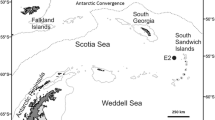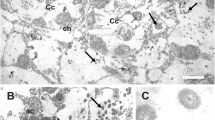Abstract
Symbiosis with microorganisms has been well documented for many marine invertebrate taxa. However, knowledge of the diversity of microorganisms associated with ascidians is still limited. This study assessed the microbial epibionts of Didemnum galacteum and Cystodytes sp., two ascidian species collected from the western coast of Ceará state (Brazil), at Dois Coqueiros beach and the port of Pecém, respectively. The microbiota were examined using optical microscopy, followed by subsequent analysis of fingerprinting profiles obtained by denaturing gradient gel electrophoresis (DGGE) and 16S rRNA clone libraries. The microscopy analysis showed for both ascidians a community comprising cyanobacteria, mainly Prochloron-like species, and diatoms. The DGGE results indicated that D. galacteum hosts a more diverse microbiota when compared to Cystodytes sp. The same analysis also suggested that the diversity of the seawater microbiota was higher than the diversity of the ascidian-associated microbiota. The analysis of the 16S rRNA clone libraries revealed the dominance of Proteobacteria symbionts associated with both ascidians, with Alphaproteobacteria as the major component in D. galacteum and Gammaproteobacteria the major component in Cystodytes sp. The analysis of the clone libraries also revealed the presence of other taxa such as Bacteroidetes, Planctomycetes, Actinobacteria, Cyanobacteria, and uncultured bacteria in D. galacteum, but not in Cystodytes sp. Among the bacteria found to be exclusively associated with the ascidians, none were shared by the two studied hosts. The combined results point to a diverse microbiota associated with the external surface of the ascidians, with a mixed composition including organisms typically found in the surrounding seawater, but also a more specific set of taxa.







Similar content being viewed by others
References
Behrendt L, Larkum AWD, Trampe E, Norman A, Sørensen SJ, Kühl M (2012) Microbial diversity of biofilm communities in microniches associated with the didemnid ascidian Lissoclinum patella. ISME J 6:1222–1237
Bright M, Bulgheresi S (2010) A complex journey: transmission of microbial symbionts. Nat Rev Microbiol 8:218–230
Cox GC (1986) Comparison of prochloron from different hosts. i. structural and ultrastructural characteristics. New Phytol 104:429–445
Donia MS, Fricke WF, Partensky F, Cox J, Elshahawi SI, White JR, Phillippy AM, Schatz MC, Piel J, Haygood MG, Ravel J, Schmidt EW (2011) Complex microbiome underlying secondary and primary metabolism in the tunicate-Prochloron symbiosis. P Natl Acad Sci USA 108:E1423–E1432
Dunlap WC, Battershill CN, Liptrot CH, Cobb RE, Bourne DG, Jaspars M, Long PF, Newman DJ (2007) Biomedicinals from the photosymbionts of marine invertebrates: a molecular approach. Methods 42:358–376
Groepler W, Schuett C (2003) Bacterial community in the tunic matrix of a colonial ascidian Diplosoma migrans. Helgoland Mar Res 57:139–143
Hirose E, Fukuda T (2006) Vertical transmission of photosymbionts in the colonial ascidian Didemnum molle: The larval tunic prevents symbionts from attaching to the anterior part of larvae. Zool Sci 23:669–674
Hirose E, Hirose M, Neilan BA (2006) Localization of symbiotic cyanobacteria in the colonial ascidian Trididemnum miniatum (Didemnidae, Ascidiacea). Zool Sci 23:435–442
Hirose E, Uchida H, Murakami A (2009) Ultrastructural and microspectrophotometric characterization of multiple species of cyanobacterial photosymbionts coexisting in the colonial ascidian Trididemnum clinides (Tunicata, Ascidiacea, Didemnidae). Eur J Phycol 44:365–375
Jimenez PC, Fortier SC, Lotufo TMC, Pessoa C, Moraes MEA, Moraes MO, Costa-Lotufo LV (2003) Biological activity in extracts of ascidians (Tunicata, Ascidiacea) from the northeastern Brazilian coast. J Exp Mar Biol Ecol 287:93–101
Kostka JE, Prakash O, Overholt WA, Green SJ, Freyer G, Canion A, Delgardio J, Norton N, Hazen TC, Huettel M (2011) Hydrocarbon-degrading bacteria and the bacterial community response in Gulf of Mexico beach sands impacted by the Deepwater Horizon oil spill. Appl Environ Microbiol 77:7962–7974
Kott P (1984) Related species of Trididemnum in symbiosis with Cyanophyta. P Linn Soc NSW 107:515–520
Kott P, Parry DL, Cox GC (1984) Prokaryotic symbionts with a range of ascidian hosts. B Mar Sci 34:308–312
Lambert G (2005) Ecology and natural history of the Protochordates. Can J Zoolog 83:34–50
Lewin RA, Cheng L, Lafargue F (1980) Prochlorophytes in the Caribbean. B Mar Sci 30:744–745
López-Legentil S, Song B, Bosch M, Pawlik JR, Turon X (2011) Cyanobacterial diversity and a new Acaryochloris-like symbiont from Bahamian sea-squirts. PLoS One 6:1–12
Lotufo TMC, Dias GM (2007) Didemnum galacteum, a new species of white Didemnid (Chordata: Ascidiacea: Didemnidae) from Brazil. Proc Biol Soc Wash 120:137–142
Lotufo TMC, Silva AMB (2006) Ascidiacea. In: Matthews-Cascon H, Lotufo TMC (eds) Biota Marinha da Costa Oeste do Ceará. Ministério do Meio Ambiente, Brasília, pp 221–248
Martínez-García M, Díaz-Valdes M, Ramos-Esplá A, Salvador N, Lopez P, Larriba E, Antón J (2007a) Cytotoxicity of the ascidian Cystodytes dellechiajei against tumor cells and study of the involvement of associated microbiota in the production of cytotoxic compounds. Mar Drug 5:52–70
Martínez-García M, Díaz-Valdés M, Wanner G, Ramos-Esplá A, Antón J (2007b) Microbial community associated with the colonial ascidian Cystodytes dellechiajei. Environ Microbiol 9:521–534
Martínez-García M, Díaz-Valdés M, Antón J (2010) Diversity of pufM genes, involved in aerobic anoxygenic phtosynthesis, in the bacterial communities associated with colonial ascidians. FEMS Microbiol Ecol 71:387–398
Martínez-Garcia M, Koblĩzek M, López-Legentil S, Antón J (2011) Epibiosis of oxygenic phototrophs containing chlorophylls a, b, c and d on the colonial ascidian Cystodytes dellechiajei. Microbiol Ecol 61:13–19
Menezes CBA, Bonugli-Santos RC, Miqueletto PB, Passarini MRZ, Silva CHD, Justo MR, Leal RR, Fantinatti-Garboggini F, Oliveira VM, Berlinck RGS, Sette LD (2010) Microbial diversity associated with algae, ascidians and sponges from the north coast of São Paulo state, Brazil. Microbiol Res 165:466–482
Millar RH (1971) The biology of ascidians. Adv Mar Biol 9:1–100
Monniot C, Monniot F, Laboute P (1991) Coral reef ascidians of New Caledonia. collections faune tropicale. ORSTOM Editions, Paris
Moss C, Green DH, Pérez B, Velasco A, Henríquez R, Mckenzie JD (2003) Intracellular bacteria associated with the ascidian Esteinascidia turbinata: phylogenetic and in situ hydridization analysis. Mar Biol 14:99–110
Nogales B, Aguiló-Ferretjans MM, Martín-Cardona C, Latucat J, Bosch R (2007) Bacterial diversity, composition and dynamics in and around recreational coastal areas. Environ Microbiol 9:1913–1929
Oka AT, Suetsugu M, Hirose E (2005) Two new species of Diplosoma (Ascidiacea: Didemnidae) bearing prokaryotic algae Prochloron from Okinawajima (Ryukyu Archipelago, Japan). Zool Sci 22:367–374
Øvreås L, Forney L, Daae FL, Torsvik V (1997) Distribuition of bacterioplankton in meromictic Lake Saelenvannet as determined by denaturing gradient gel electrophoresis of PCR amplified gene fragments coding for 16S rRNA. Appl Environ Microbiol 63:3367–3373
Pérez-Matos AE, Rosado W, Govind NS (2007) Bacterial diversity associated with the Caribbean tunicate Ecteinascidia turbinata. Anton Leeuw Int J G 92:155–164
Roger SO, Bendich AJ (1985) Extraction of DNA from milligram amounts of fresh, herbarium and mummified plant-tissues. Plant Mol Biol 5:69–76
Schloss PD, Handelsman J (2005) Introducing DOTUR, a computer program for defining operational taxonomic units and estimating species richness. Appl Environ Microbiol 71:1501–1506
Schmidt EW, Sudek S, Haygood MG (2004) Genetic evidence supports secondary metabolic diversity in Prochloron spp., the cyanobacterial symbiont of a tropical ascidian. J Nat Prod 67:1341–1345
Schmidt EW, Donia MS, McIntosh JA, Fricke WF, Ravel J (2012) Origin and variation of tunicate secondary metabolites. J Nat Prod 75:295–304
Schuett C, Doepke H, Groepler W, Wichels A (2005) Diversity of intratunical bacteria in the tunic matrix of the colonial ascidian Diplosoma migrans. Helgoland Mar Res 59:136–140
Tait E, Carman M, Sievert SM (2007) Phylogenetic diversity of bacteria associated with ascidians in Eel Pond (Woods Hole, Massachusetts, USA). J Exp Mar Biol Ecol 342:138–146
Acknowledgment
This research project was funded through a scholarship for F.A.S.O. from Coordenação de Aperfeiçoamento de Pessoal de Nível Superior.
Author information
Authors and Affiliations
Corresponding author
Rights and permissions
About this article
Cite this article
da Silva Oliveira, F.A., Colares, G.B., Hissa, D.C. et al. Microbial epibionts of the colonial ascidians Didemnum galacteum and Cystodytes sp.. Symbiosis 59, 57–63 (2013). https://doi.org/10.1007/s13199-012-0210-2
Received:
Accepted:
Published:
Issue Date:
DOI: https://doi.org/10.1007/s13199-012-0210-2




